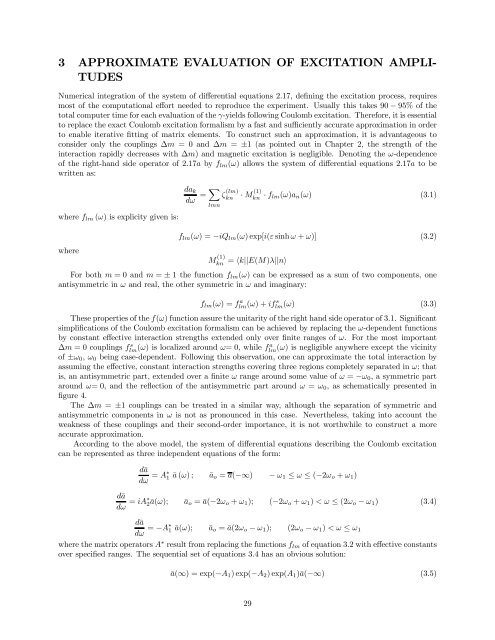coulomb excitation data analysis codes; gosia 2007 - Physics and ...
coulomb excitation data analysis codes; gosia 2007 - Physics and ...
coulomb excitation data analysis codes; gosia 2007 - Physics and ...
You also want an ePaper? Increase the reach of your titles
YUMPU automatically turns print PDFs into web optimized ePapers that Google loves.
3 APPROXIMATE EVALUATION OF EXCITATION AMPLI-TUDESNumerical integration of the system of differential equations 2.17, defining the <strong>excitation</strong> process, requiresmost of the computational effort needed to reproduce the experiment. Usually this takes 90 − 95% of thetotal computer time for each evaluation of the γ-yields following Coulomb <strong>excitation</strong>. Therefore, it is essentialto replace the exact Coulomb <strong>excitation</strong> formalism by a fast <strong>and</strong> sufficiently accurate approximation in orderto enable iterative fitting of matrix elements. To construct such an approximation, it is advantageous toconsider only the couplings ∆m =0<strong>and</strong> ∆m = ±1 (as pointed out in Chapter 2, the strength of theinteraction rapidly decreases with ∆m) <strong>and</strong> magnetic <strong>excitation</strong> is negligible. Denoting the ω-dependenceof the right-h<strong>and</strong> side operator of 2.17a by f lm (ω) allows the system of differential equations 2.17a to bewritten as:where f lm (ω) is explicity given is:whereda kdω = X ζ (lm)kn · M (1)kn · f lm(ω)a n (ω) (3.1)lmnf lm (ω) =−iQ lm (ω)exp[i(ε sinh ω + ω)] (3.2)M (1)kn = hk||E(M)λ||niFor both m =0 <strong>and</strong> m = ± 1 the function f lm (ω) can be expressed as a sum of two components, oneantisymmetric in ω <strong>and</strong> real, the other symmetric in ω <strong>and</strong> imaginary:f lm (ω) =f a lm(ω)+if s lm(ω) (3.3)These properties of the f(ω) function assure the unitarity of the right h<strong>and</strong> side operator of 3.1. Significantsimplifications of the Coulomb <strong>excitation</strong> formalism can be achieved by replacing the ω-dependent functionsby constant effective interaction strengths extended only over finite ranges of ω. For the most important∆m =0couplings flm s (ω) is localized around ω= 0, while f lm a (ω) is negligible anywhere except the vicinityof ±ω 0 , ω 0 being case-dependent. Following this observation, one can approximate the total interaction byassuming the effective, constant interaction strengths covering three regions completely separated in ω; thatis, an antisymmetric part, extended over a finite ω range around some value of ω = −ω 0 , a symmetric partaround ω= 0,<strong>and</strong>thereflection of the antisymmetric part around ω = ω 0 , as schematically presented infigure 4.The ∆m = ±1 couplings can be treated in a similar way, although the separation of symmetric <strong>and</strong>antisymmetric components in ω is not as pronounced in this case. Nevertheless, taking into account theweakness of these couplings <strong>and</strong> their second-order importance, it is not worthwhile to construct a moreaccurate approximation.According to the above model, the system of differential equations describing the Coulomb <strong>excitation</strong>can be represented as three independent equations of the form:dādω = A∗ 1 ā (ω); ā o = a(−∞) − ω 1 ≤ ω ≤ (−2ω o + ω 1 )dādω = iA∗ 2ā(ω); ā o =ā(−2ω o + ω 1 ); (−2ω o + ω 1 )
















